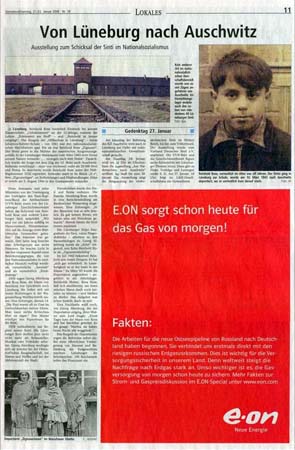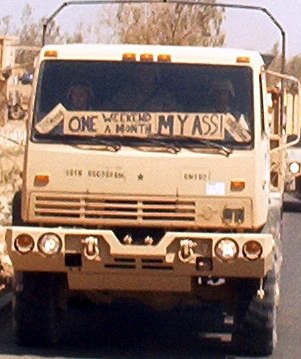advertising
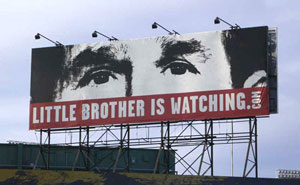
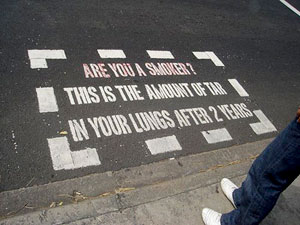
(via)
Update: Houtlust is now Osocio.
Contextual Advertising, Redux
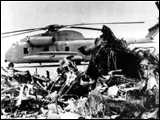 Reader Ravenmn writes:
Reader Ravenmn writes:
“Your item about the bad ad placement in Germany reminds me of an experience I had as a typesetter at the Minnesota Daily, the student newspaper of the University of Minnesota. In April of 1980, nobody noticed that the Army Helicopter Pilot Training ROTC ad was running on the same page as the story of the failed helicopter rescue attempt Jimmy Carter sent to Iran during the hostage crisis, complete with photo of mangled helicopters in the desert. ROTC got a couple of free ads out of it, if I recall correctly.”
I found the photo on http://remember.gov, the Web site White House Commission on Remembrance, your official source for state-sponsored memory.
Contextual Advertising Gone Bad
A week before today’s 61st anniversary of the liberation of Auschwitz by the Red Army, Landeszeitung Lüneburg, a local newspaper in Germany, ran an article about the deportation of a Sinti boy from Lüneburg to Auschwitz.
The article was accompanied by a large red ad from one of the biggest energy companies in Germany bearing the tagline (roughly translated): “E.ON provides today for the gas of tomorrow!”
Click for a larger version.
The paper later published an apology to the author, readers, and energy company for the ad placement, claiming they had not checked the content of the ad.
Serve and Protect
From AP, August 26, 2002:
Florida police cars to sport corporate logos
“SPRINGFIELD, Fla. — This Florida Panhandle town is getting new police cars for only $1 each, but there’s a catch. The cars will be festooned with corporate sponsorship logos similar to those on race cars.
City commissioners voted 4-0 Thursday to accept the deal with Charlotte, N.C.-based Government Acquisitions. The company hopes to provide a new squad car for each of Springfield’s 15 officers within the next three years.
Government Acquisitions partner Ken Allison said advertising on cruisers destined for the Panama City suburb would be toned down.
Police Chief Sam Slay said the city could save about $500,000 over the three-year span.
‘You are talking about $500,000 that can be spent other places in the city, and that’s what this program is for,’ said Mayor Robert Walker.
Slay wants the savings used to hire two more officers, but Commissioner Carl Curti said other departments may need the money. Slay said his department should get to keep use the money instead of being punished for saving it.
Curti also was apprehensive about using the police car budget for other purposes.
‘These free cars may not always be free cars,’ Curti said.”
One Weekend a Month My Ass!
A U.S. reservist in Iraq emails a photo to a friend back home. Friend posts it on his blog. The image is widely circulated by email, and ultimately finds mention in The New York Times a month later.
The war drags on. Tours of duty are extended. U.S. soldiers continue to kill and be killed. Dissent among the military and military families smoulders.
And the scholarship funding? Job skills? Veteran’s benefits? One weekend a month?
See these articles about the myths and messages in military graphics and advertising sold by recruiters to high school and college students across the United States of America.
Aussie Military Pulls College Ads over Parody
From The Sunday Mail:
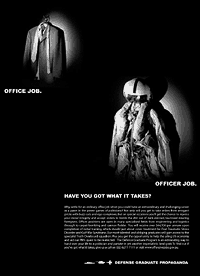 “[Australia’s] Department of Defence appears to have pulled all its advertising from every student newspaper in the country because one Sydney publication made fun of it.
“[Australia’s] Department of Defence appears to have pulled all its advertising from every student newspaper in the country because one Sydney publication made fun of it.
The University of Technology Sydney student newspaper Vertigo ran a satirical ad to counter recruitment advertisements appearing in other publications and voice the editors’ opposition to war on Iraq.
Under the heading, ‘Have you got what it takes?’, the ad reads:
‘Why settle for an ordinary office job when you could have an extraordinary and challenging career as a pawn in the power games of politicians?
‘Not only will you get to take orders from arrogant pricks with buzz-cuts and ego complexes, but on special occasions you’ll get the chance to repress your moral integrity and accept orders to bomb the shit out of dark-skinned, tea towel wearing foreigners.’
Vertigo editor Jano Gibson said that after seeing the ad, the Defence Department pulled all advertising from every student paper in the country.
The move comes at a time when many student newspapers are struggling for financial survival and increasingly reliant upon advertising.
But far from being disappointed, the editors are thrilled that they have eliminated all Defence ads, saying the Government had played right into their hands.
Mr Gibson said Vertigo had already refused ads from the department and was trying to get other student papers to do the same.
‘In effect the Department of Defence has fulfilled our intentions in having a boycott across the rest of Australia,’ he told AAP.
‘We see it as a great victory that students are no longer being inundated with false representations of the defence forces.’”
From the Sydney IndyMedia:
“As an act of solidarity the parody will also be reprinted by Rabelais, the student paper of La Trobe University, and Lot’s Wife, the student publication of Monash University, with more possibly to follow.”
The Committee to Help Unsell the War
In 1969, Arkansas Senator J. William Fulbright, announced the results of his investigation into the Defense Department’s lavish spending on propaganda and self-promotion during the Vietnam War.
Mitchell Hall writes in Unsell the War: Vietnam and Antiwar Advertising, (Historian, Autumn 1995):
“From 1959 to 1969, the Pentagon’s public relations expenditures increased 1,000 percent to an acknowledged $27.9 million, a figure Fulbright called ‘conservative.’ With this financing and a full-time public information force of 2,800 people, the military enjoyed overwhelming access to the public. In 1968 the navy and marines sent over 2.8 million news releases to 12,000 print and broadcast media outlets, in 1969 armed forces performances ranging from musical groups to aerial demonstrations played to audiences estimated at 20 million, and over 360 commercial and educational television stations used the U.S. Army-produced TV show ‘Big Picture.’ The potential influence on public opinion and foreign policy was enormous.
U.S. presidents from Harry Truman to Richard Nixon had also tried to persuade the public that events in Indochina demanded a U.S. military presence. Their efforts initially succeeded, but by the late 1960s millions of Americans had publicly demonstrated their rejection of a policy that had brought increasing sacrifice, destruction, and stalemate. Nixon’s Vietnamization policy, which gradually removed U.S. ground troops but escalated the bombing, partially defused antiwar activity by early 1971. Decreasing U.S. casualties convinced many people that the war was winding down. Although massive public demonstrations occurred less frequently than before, citizens in the early 1970s continued to work to end the war in numerous and creative ways.
On February 23, 1971, CBS broadcast the documentary “The Selling of the Pentagon.”
“Reiterating many of the points addressed in Fulbright’s report, this hour-long program examined the Defense Department’s public relations efforts that, in addition to recruiting volunteers and providing information, marketed a specific interpretation of the Vietnam War and the cold war to the U.S. public....
The military establishment annually arranged hundreds of public contacts that included shopping mall exhibits, Green Beret hand-to-hand combat demonstrations, and tours by flight teams such as the Thunderbirds. In clear violation of regulations, a select group of colonels avidly promoted the U.S. presence in Vietnam in speeches they gave around the country. The Defense Department also provided weekend guided tours of military installations to VIPs, who could observe war games from a grandstand and personally fire tank guns and artillery.
Films also propagated the military’s ideology. The Pentagon cooperated with Hollywood producers who portrayed the military favorably and had celebrities and journalists narrate some of its own movies....
The Defense Department achieved its widest exposure through the news media. Daily briefings to the national press yielded only carefully selected information from the Pentagon’s public relations division. The armed forces also maintained their own media arm, producing over two million press releases each year. Local newspapers generally snapped up uncritically this flood of news about the awarding of medals and promotions. Military television crews provided combat footage to supplement network coverage but often staged the action. Similarly military officials frequently held pre-interview briefings with soldiers in the field to ensure a standard acceptable story before allowing network TV reporters access to them. CBS questioned the impact on a democratic society and free press of a vast military information system that portrayed violence as glamorous, advertised expensive weapons like cars, and presented biased opinion as fact.”
Ira Nerken, a junior at Yale University studying political science, missed the initial broadcast of ”The Selling of the Pentagon” but read about the controversy it provoked. He decided that the war could be ‘unsold’ to the American public. Print ads had occasionally appeared in leading newspapers, and ad hoc groups produced some radio and television spots, but the advertising world had never been tapped on a large scale.
After discussing his ideas with an instructor at Yale, the instructor introduced him to David McCall, president of LaRoche, McCaffrey & McCall, an ad agency in New York. McCall and James McCaffrey, the agency’s chair, quickly organized a team that produced a poster and letter of explanation seeking support for a campaign to unsell the war. These were sent to 80 executives in 60 agencies.
The initial poster featured a drawing of the Pentagon and the headline, “Help unsell the war.” It read:
“C.B.S. recently devoted an hour to documenting the enormous advertising and public-relations job the Pentagon has done to sell the American public its version of the war. A group of students and faculty at Yale University are asking the men and women of the advertising agency business who disagree with the Pentagon’s version of the war to create advertising in all forms that will help unsell the war.”
The letter closed:
“Needless to say, we are not interested in cheap, superficial, anti-American work, we are interested in thoughtful and honest advertising, created by people who love their country.
I hope you will agree with me that this is a vital contribution which our business can make. If you do not agree, I can understand that, too. But the Pentagon’s side of the story has been ably and massively told. Ours has not.”
 Interested ad executives were invited to briefing at Yale University on April 3, 1971.
Interested ad executives were invited to briefing at Yale University on April 3, 1971.
“Over two hundred New York advertising people attended the early April briefing at Yale’s law school auditorium. Paul Warnke, former assistant secretary of defense, and Morton Halperin, former deputy assistant secretary of defense, explained Nixon’s Vietnam policies, and both urged setting a deadline for total withdrawal of U.S. troops. A representative of Vietnam Veterans Against the War discussed war crimes and problems veterans faced. A member of Concerned Asian Scholars described corruption within the Saigon government and the spreading antiwar feeling in South Vietnam. A person from the Herbicide Assessment Commission to South Vietnam showed slides of defoliation and crop destruction, and a former ABC correspondent in Vietnam detailed the strained relationship between the press and the military. Perhaps the most influential speaker was Milton Rosenberg, professor of social psychology from the University of Chicago. He identified the constituencies most ambivalent about the war and the arguments most likely to turn them against it: the deaths of U.S. troops, the economic consequences for the United States, and the creation of national discord.”
After the briefing, the attendees were asked to produce ads to be reviewed on May 1 by a panel that included Kingman Erewster, president of Yale; Mort Halpern, former Deputy Assistant Secretary of Defense; Dr. Edwin Reischauer, former Ambassador to Japan, and Gen. David M. Shoup of the United States Marine Corps (retired.) The panel would evaluate the ads and eliminate those that were inaccurate, unfair, or inferior.
On Memorial Day, May 31, the ads and commercials were to be displayed and distributed to the media to run as a public service.
Over 300 writers, artists, directors, and producers from nearly 50 ad agencies contributed an estimated $1 million of time and expenses. As of June 8, 1971, 125 print ads, 33 TV commercials and 31 radio spots had been produced. Given the expense of reproducing the ads, only a handful were sent to media outlets.
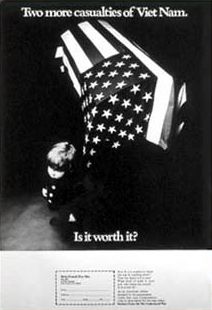 Though the Committee never did convince the major broadcast networks to air the ads, over 100 TV stations and 350 locally owned radio stations around the U.S. did run the spots. During the summer of 71, Nerken was able to arrange free time on 285 billboards around the country. Many of the ads urged people to elect representatives who would vote to end the war by the end of the year.
Though the Committee never did convince the major broadcast networks to air the ads, over 100 TV stations and 350 locally owned radio stations around the U.S. did run the spots. During the summer of 71, Nerken was able to arrange free time on 285 billboards around the country. Many of the ads urged people to elect representatives who would vote to end the war by the end of the year.
“With its attention focused on production rather than marketing, Unsell encountered additional problems inherent in the campaign. It lacked a built-in constituency or the organizational resources to conduct a national distribution effort. Local media felt little pressure to run ads offered by mail from New York. The result was a relative lack of success in getting messages on the air and in print. Because many ads focused on U.S. casualties, the sell became harder as Vietnamization brought more U.S. troops home in favor of an escalated air war, diluting one of the Unsell campaign’s central themes.”
In 1972, the expense and demands of the campaign ultimately led to its transfer to Clergy and Laymen Concerned, the nation’s largest religiously oriented antiwar organization. The focus of ad production also shifted from New York City to Hollywood. The CALC’s network of local chapters were also able to decentralize the task of contacting local media for free time and space. National organizations such as the American Friends Service Committee, Another Mother For Peace, and the Fellowship of Reconciliation also urged their members to get involved in the campaign.
In addition to the decline in U.S. casualties, the ongoing financial burden of the campaign and the 1972 presidential election slowed the momentum of the project which ultimately ended after the reelection of President Nixon and his announcement in January 1973 of an accord with North Viet Nam to end American involvement in Indochina.
The Library of Congress has several thumbnail images of posters produced by the Committee. Click on ‘Preview Images.’
The Poster that Won the Election

From The Guardian:
“The Conservative party’s 1978 poster of a snaking line of people queuing for the unemployment office under the slogan ‘Labour isn’t working’ has been voted the poster advertisement of the century [by the trade magazine Campaign].
Created by the Saatchi brothers, the poster is cited as instrumental in the downfall of James Callaghan’s Labour administration in the 1979 election and the rise of Margaret Thatcher, partly because he rose to the jibe and complained [about the poster in Parliament]. It also marked a sea-change in political advertising as, aiming at traditional Labour supporters who feared for their jobs, it was the first to adopt the aggressive marketing tactics which characterise modern elections.
The BBC has a story on the background of the Labour poster and how the photo was faked.
“News that people in the advert were ‘actors’ and not genuinely unemployed had leaked and Healed said the Conservatives were dishonest, reaching a new low by ‘selling politics like soap-powder’.
But Labour politicians were not hawk-eyed enough to spot that the basic ‘deceit’ was compounded by using the same few people over and over. Walsh had ensured that the volunteers’ faces were out of focus and could not be recognised.
Since then the tactic of putting up a deliberately controversial poster on a few bill-boards - and then reaping millions of pounds of free publicity as TV and newspapers report the fuss has become a standard and cost-effective tactic for advertisers.
When the election was delayed until the spring of 1979 the Saatchis brought out a second version of the poster with the legend ‘Labour still isn’t working’.
After the election Lord Thorneycroft, Tory party treasurer at the time, claimed that the poster had ‘won the election for the Conservatives’.”
Found via coudal partners.
Nike Lawsuit Moves Forward
In April 1998, activist Marc Kasky and attorney Alan Caplan filed a lawsuit claiming that Nike had engaged in unfair business practices by falsely advertising its Asian labor conditions. Nike claimed that its public relations campaign in which it said it did not run sweatshops could not be challenged under false-advertising laws because it was protected as non-commercial speech by the First Amendment. In a ruling issued on May 2, 2002, the California Supreme Court did not agree, and now a lawsuit against the company can move forward. Considering the evidence that the statements they made were false, this looks like a major blow to greenwashing campaigns across the board. Source: American Samizdat and AnitaRoddick.com. See also law.com, CorpWatch.org, and Nike’s press release which notes that their position was “strongly supported by the ACLU.”
Update, 1/11/03: The case is headed for the Supreme Court.
page 2 1


